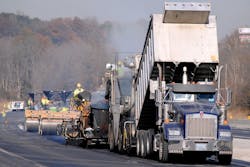By: James A. Scherocman, P.E.
The single most important factor that affects the long-term durability of a hot mix asphalt (HMA) pavement is the density of the mix that is achieved by the contractor at the time of construction. The density of a material is defined as the weight of the material, which occupies a certain volume of space. The compaction process causes the asphalt-concrete mix to be compressed and its volume reduced. As the density of the hot-mix asphalt material increases, the air-void content of the mix decreases (they are inversely proportional to each other). Properly designed, a HMA mix should have an air-void content in the range of 3% to 5%.
If the compacted hot-mix asphalt has a high air-void content (greater than 8%), the mix will not perform as well under traffic. Similarly, if the compacted asphalt mix has a low air-void content (less than 3%), the mix will be susceptible to permanent deformation or rutting and also to distortion under the applied traffic loads. Thus, for the mix to perform as expected, the contractor must be able to compact the mix to the desired level of density or air-void content.
The density of the asphalt-concrete mix controls its durability. All of the following factors are related to the air-void content of the hot-mix asphalt material: fatigue life; permanent deformation; oxidation; moisture damage; distortion; and disintegration.
As the air void of the hot-mix asphalt decreases, the fatigue life or number of repetitions of load to failure of that mix increases. Tests have shown that reducing the air-void content of a given asphalt-concrete mix from 8% to 5% can double the fatigue life of the pavement. Thus, for a given thickness of HMA as part of the pavement structure, the ability of the mix to carry load can be increased significantly when the mix is compacted to a lower air-void content.
Troubleshooting
The amount of permanent deformation or rutting that develops under load in a hot-mix asphalt material also is directly related to the air-void content of the mix. As the air-void content decreases, the amount of rutting that will occur in that mix also decreases. If the mix design is proper, a well compacted mix will not rut under the action of the traffic loads. If the mix design is deficient in some aspect, proper compaction of the mixture can still significantly reduce the amount of rutting and lateral distortion that will occur under repeated load applications. If, however, the air-void content of the mix is reduced to less than 3%, an increase in the rate of rutting of the mix can result.
With time, the asphalt-cement binder in an asphalt-concrete mix will oxidize and become more brittle. This oxidation or aging process causes the asphalt cement to decrease in penetration and increase in viscosity. The rate of oxidation is directly related to the air-void content of the mix. The lower the air-void content, the less quickly the hot-mix asphalt material will age and become stiffer.
Moisture damage or stripping occurs when water is able to enter the mix and, under the repetitive action of traffic, works its way in between the asphalt coating on the aggregate and the surface of the aggregate. The degree of moisture damage is primarily related to the characteristics of the aggregate used in the mix but also is directly related to the air-void content of the mix. As the air-void content in the mix decreases, the amount of moisture damage also decreases. Indeed, a mix that may strip badly at an air-void content of 8% may not suffer any moisture damage if it can be compacted to an air-void content below 4%.
Distortion or shoving is the displacement of the mix, typically in the longitudinal direction, under the action of traffic. Distortion is primarily related to the design and properties of the mix but also is related to the air-void content. For a given mix, a decrease in the air-void content at the time of construction will decrease the amount of distortion that the mix will undergo when exposed to traffic loads, particularly stopping or turning movements. An increase in the density of the mix (a decrease in the air-void content) will increase the internal stability and strength of the mix and may significantly reduce the amount of distortion that occurs under load.
Disintegration or raveling is directly related to the air-void content of the mix. If a mix is properly compacted (to an air-void content of 8% or less), the mix generally will not ravel if the asphalt content is correct. If the same mix is compacted to a high air-void content, however, major raveling may occur under the applied traffic loads. As the air-void content of the mix decreases, the amount of raveling also will decrease.
An asphalt-concrete mix must be fully compacted before it cools to a temperature of about 175 F. At temperatures above this value, the mix is normally still warm enough for the compaction equipment to reorient the aggregate particles into their densest configuration. Below that temperature, however, the mix is generally too stiff to increase in density any significant amount with continued rolling, although roller marks can often be removed below this compaction cutoff temperature. The mix must, therefore, be compacted while it is still hot. Five factors directly affect the rate of cooling of the asphalt concrete mix when that material is placed on top of another existing layer of the pavement structure. Those variables are: air temperature; base temperature; mix laydown temperature; layer thickness; and wind velocity.
All other factors being equal, as the ambient air temperature increases, the time available for compaction also increases. The mix will take longer to cool to the cutoff temperature of 175 F on a warm day than on a cool day. An increase in the air temperature allows more time for the compaction equipment to achieve the desired density level in the mix.
More important than air temperature in the rate of cooling of the hot-mix asphalt mix is the temperature of the surface of the layer on which the new mix is placed. It is well known that heat in an asphalt concrete layer is lost in two directions. The surface of the mixture cools as heat is transferred to the air. The bottom portion of the mixture also cools as heat is transferred to the underlying base material. There is more rapid cooling of the mix downward into the base than upward into the ambient air.
Base temperature-the temperature of the layer on which the new asphalt concrete mix is placed-is actually more important than air temperature in determining the time available for compaction. An increase in the base temperature allows more time for compaction.
As the temperature of the mix coming out from under the paver screed increases, the time available for compaction also increases. A mix placed at a temperature of 300 F, for a given lift thickness and other environmental factors, will take longer to cool to the cutoff temperature of 175 F than will the same mix placed at a temperature of 250 F.
Thickness is critical component to cooling rate
Probably the most important factor in the rate of cooling of an asphalt concrete mix is the thickness of the layer being placed and compacted. As the thickness of the layer increases, the time available for compaction also increases. It takes considerably longer for a 3-in. thick layer of hot-mix asphalt to cool to the cutoff temperature of 175 F than for a 1-in. layer to cool to the same temperature. The cooling time is not directly proportional to the lift thickness but is geometrically proportional. For example on a 40 F day with the temperature of the base at the same value, a 3-in. thick layer of HMA placed at a temperature of 250 F will take 19 minutes to cool from the laydown temperature to the cutoff temperature of 175 F. On the same 40 F day, with the same base temperature and for the same mix laydown temperature of 250 F, a 1-in. thick HMA layer will cool to the cutoff temperature in only 3 minutes.
A thin lift of asphalt-concrete mix will cool more quickly when exposed to a high wind velocity than when there is little or no wind. Wind has a much greater effect on the surface of the mix than at various depths within the HMA layer. A strong wind can cause the surface to cool so rapidly that a crust will form. This crust must be broken down by the rollers before the compaction process can be accomplished. The higher the wind velocity, the less time available for compaction, all other factors being constant.
Dickson and Corlew published a set of cooling curves for asphalt concrete mixtures. Those curves show the amount of time available for compaction under different combinations of conditions. The curves are reproduced in Section Six of Part Three of the Hot Mix Asphalt Paving Handbook, available from the National Asphalt Pavement Association. Three variables are used to enter the graphs: Mix-laydown temperature, base temperature (which is assumed to be equal to the air temperature), and compacted layer thickness.



